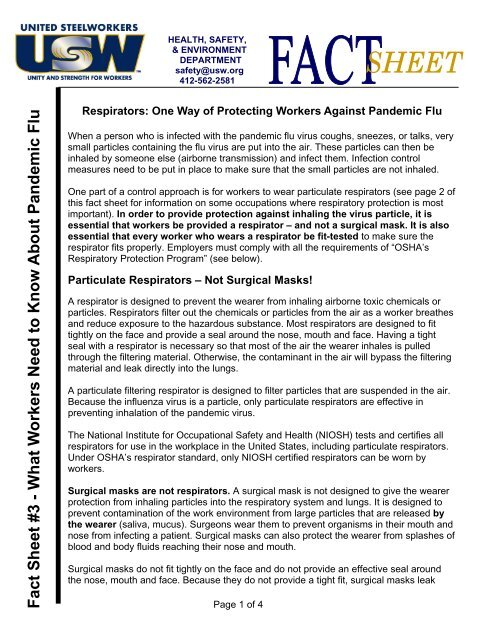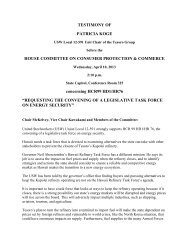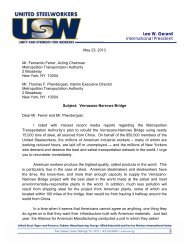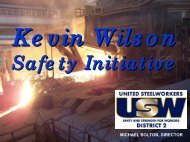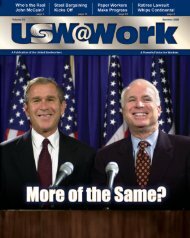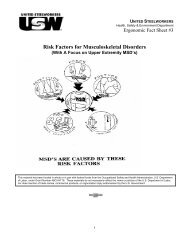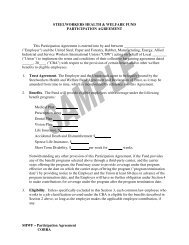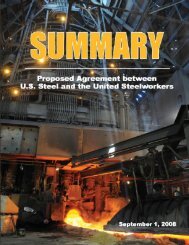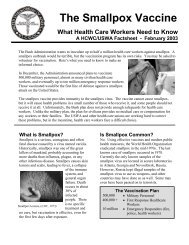Fact Sheet #3 - United Steelworkers
Fact Sheet #3 - United Steelworkers
Fact Sheet #3 - United Steelworkers
You also want an ePaper? Increase the reach of your titles
YUMPU automatically turns print PDFs into web optimized ePapers that Google loves.
HEALTH, SAFETY,& ENVIRONMENTDEPARTMENTsafety@usw.org412-562-2581SHEET<strong>Fact</strong> <strong>Sheet</strong> <strong>#3</strong> - What Workers Need to Know About Pandemic FluRespirators: One Way of Protecting Workers Against Pandemic FluWhen a person who is infected with the pandemic flu virus coughs, sneezes, or talks, verysmall particles containing the flu virus are put into the air. These particles can then beinhaled by someone else (airborne transmission) and infect them. Infection controlmeasures need to be put in place to make sure that the small particles are not inhaled.One part of a control approach is for workers to wear particulate respirators (see page 2 ofthis fact sheet for information on some occupations where respiratory protection is mostimportant). In order to provide protection against inhaling the virus particle, it isessential that workers be provided a respirator – and not a surgical mask. It is alsoessential that every worker who wears a respirator be fit-tested to make sure therespirator fits properly. Employers must comply with all the requirements of “OSHA’sRespiratory Protection Program” (see below).Particulate Respirators – Not Surgical Masks!A respirator is designed to prevent the wearer from inhaling airborne toxic chemicals orparticles. Respirators filter out the chemicals or particles from the air as a worker breathesand reduce exposure to the hazardous substance. Most respirators are designed to fittightly on the face and provide a seal around the nose, mouth and face. Having a tightseal with a respirator is necessary so that most of the air the wearer inhales is pulledthrough the filtering material. Otherwise, the contaminant in the air will bypass the filteringmaterial and leak directly into the lungs.A particulate filtering respirator is designed to filter particles that are suspended in the air.Because the influenza virus is a particle, only particulate respirators are effective inpreventing inhalation of the pandemic virus.The National Institute for Occupational Safety and Health (NIOSH) tests and certifies allrespirators for use in the workplace in the <strong>United</strong> States, including particulate respirators.Under OSHA’s respirator standard, only NIOSH certified respirators can be worn byworkers.Surgical masks are not respirators. A surgical mask is not designed to give the wearerprotection from inhaling particles into the respiratory system and lungs. It is designed toprevent contamination of the work environment from large particles that are released bythe wearer (saliva, mucus). Surgeons wear them to prevent organisms in their mouth andnose from infecting a patient. Surgical masks can also protect the wearer from splashes ofblood and body fluids reaching their nose and mouth.Surgical masks do not fit tightly on the face and do not provide an effective seal aroundthe nose, mouth and face. Because they do not provide a tight fit, surgical masks leakPage 1 of 4
contaminated air through gaps between the mask and the face and allow the particles toenter the wearer’s respiratory system. The filtering materials of surgical masks are also notdesigned to efficiently capture the particles. Surgical masks are not certified by NIOSH asrespirators and OSHA prohibits their use for protection against inhalation hazards in theworkplace. Surgical masks must never be used to prevent inhalation of airbornepandemic influenza virus particles such as the H1N1 flu virus.Types of Particulate Respirators and Filtering EfficienciesThere are several types of particulate filtering respirators that workers can wear to protectagainst inhaling the pandemic flu virus:• Disposable filtering face pieces: With these, the entire face piece is made of thefiltering material. They are designed to be used once and then disposed of.• Reusable elastomeric respirators: These respirators use replaceable filters andthe face piece can be cleaned and disinfected and equipped with new filters(cartridges).• Powered air purifying respirators (PAPRs). These respirators use a batterypoweredblower to pull contaminated air through the filter, providing clean air forinhaling by the wearer. These respirators can be cleaned, disinfected, and equippedwith new filters.Particulate filtering respirators are available at three different efficiencies of capturing smallparticles – 95%, 99%, and 100% (actually 99.97 %). Particulate filters are also available inthree types that rate their resistance to exposure to oil – “N” (not resistant), “R” (somewhatresistant), and “P” (oil proof).OSHA recommends that high exposure risk workers, such as health care employees andemergency medical technicians be provided with N95 or higher rated filter respirators formost situations involving people known or suspected of being infected with pandemic flu.For procedures that are likely to generate aerosols, such as bronchoscopy and intubation,OSHA recommends use of a powered air-purifying respirator (PAPR).CDC recommends that workers in health care settings use N-95 or higher respirators duringactivities that are likely to generate aerosols, including such high risk activities asbronchoscopy and intubation. Powered air-purifying respirators (PAPRs) may be consideredfor these high risk activities as well. CDC also believes that it is “prudent” for health careworkers to use N-95 respirators for other direct care activities involving patients withconfirmed or suspected pandemic flu.For workplaces where employees have high frequency contact with the general population(such as schools, high population density environments, and some high volume retailestablishments), OSHA advises that the use of a respirator may be considered if there is anexpectation of close contact with people who have symptomatic influenza infection, or ifemployers choose to provide protection against a risk of airborne transmission.Page 2 of 4
IMPORTANT NOTE: The <strong>United</strong> <strong>Steelworkers</strong> International Union and the AFL-CIOrecommend, as a minimum level of respiratory protection, that high exposure riskworkers in health care and emergency response should wear a P100 respirator withan elastomeric face piece seal or a PAPR equipped with high efficiency filters.OSHA’s Respiratory Protection ProgramIn a flu pandemic, workers may be required to wear respirators to protect them from inhalingthe airborne virus. But it is not enough for an employer to just hand a worker a respiratorand tell him or her to wear it. Instead, anytime an employer requires respirators to be worn,the employer must establish a complete respiratory protection program under the OSHAStandard 1910.134. For employers who are not covered by OSHA, the OSHA Standard isstill a good model to follow in order to protect workers.The OSHA respirator standard has comprehensive requirements that employers must followwhenever workers are provided with respirators. Before giving out respirators, the standardsays that employers must first use feasible “engineering controls” to prevent workers frominhaling the pandemic flu virus. Engineering controls are methods used to prevent workersfrom coming into contact with the virus, such as portable ventilation systems, physicalbarriers like plastic sneeze guards worn by infected individuals, and negative pressureinfection isolation rooms. Respirators – which are personal protective equipment, notengineering controls – should be used to protect workers from pandemic flu only wheneffective engineering controls are not feasible, or while engineering controls are beinginstalled.Some of the major requirements of the standard include:• A written respiratory protection program must be developed and anadministrator assigned to oversee the entire program.• Respirators, training, and medical evaluations are to be provided at no cost to theemployee.• Only respirators certified by the National Institute for Occupational Safety andHealth (NIOSH) can be used by workers. Surgical masks, which are not certified byNIOSH, are not permitted to be worn by workers to protect against inhalation of thepandemic flu virus under the OSHA standard.• The employer must select a respirator that will protect workers from the airbornehazard they are exposed to. Since the pandemic flu virus is a “particle,” in mostcases workers should be provided with an air-purifying respirator that has filters thatwill capture particulates.Page 3 of 4
• Employers must give all workers a medical evaluation to determine their ability towear a respirator. A physician or other licensed health care professional mustevaluate the worker and issue a written recommendation on the worker’s ability touse the respirator. Workers must receive a copy of the recommendation.• Anytime a worker is given a tight-fitting face piece respirator (where therespirator face piece is supposed to seal tightly on the face of the wearer), theemployer must perform fit-testing before the respirator is worn for the first time. Afit test is used to identify a make, model and size of a respirator that fits correctly onthe face of a worker so it does not leak air around the seal of the face piece. If itleaks, the worker inhales contaminated air instead of air that has passed throughthe filter. Note that there are some respirators that do not seal tightly on the faceand do not require fit-testing, such as loose-fitting hoods and helmets.• The employer is required to conduct annual fit testing for workers who must wearrespirators.• Employers must not allow workers to wear a tight-fitting face piece respirator if theyhave any condition that interferes with getting a tight seal of the respirator with theface. This would prohibit workers from having beards or facial hair that comebetween the face and the seal of these types of respirators.• Every time a worker puts on a tight-fitting respirator, they must perform a user sealcheck to make sure they have put it on correctly so that it seals properly with theface.• Workers must receive training and information before the first use of therespirator. The standard identifies what subjects are to be covered in the training,including the uses and limitations of respirators, how to inspect and properly put onand take off the respirator, and how to do a seal check. The standard also requiresannual retraining.• Employers are required to do a program evaluation to make sure their writtenrespiratory protection program is working effectively. Employers must also talk withworkers to make sure they are using respirators properly.• Employers must keep records under the standard, including medical evaluations,fit test results, and a copy of the current written respiratory protection program.These records must also be made available to workers upon request.Following the requirements of the OSHA Respiratory Protection Standard is a criticalelement of protecting workers during a pandemic flu. All employers should be familiar withthe standard and comply with all the requirements of the standard.This fact sheet has been adapted by the <strong>United</strong> <strong>Steelworkers</strong> International Union (USW) from a factsheet on pandemic flu originally developed by the AFL-CIO in June 2009.Page 4 of 4


